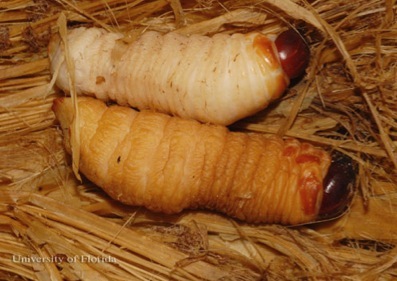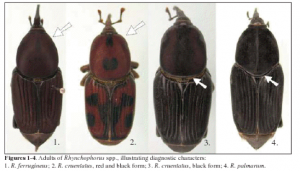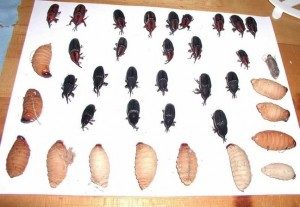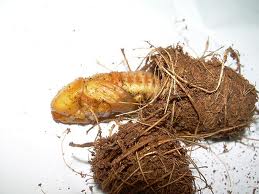Rhynchophorus cruentatus: Raw or Fried?
Here’s what you’re looking for: A palm or plametto that is dying. The growing tip is dead, bent or otherwise distorted. Maybe it was hit by lightning making it vulnerable. But you want to find a palm that is on its way out. It is in that dying top you will probably find the only species of Palmetto Weevil in the United States, Rhynchophorus cruentatus, of the greater Curculio clan just like the acorn and pecan grubs. Look at the base of the growing fronds, or wounds and cuts, late spring into the summer. The young heart leaf will pull out easily and show signs of tunneling. Don’t forget to check deceased palms as well.
Also called Grugru (GREW-grew) in South America because it makes a clicking noise while feeding, the grub eats the pith of palms and sugar cane. It’s the largest weevil in North America — up to nearly two inches — and its grub is considered a prized food. In fact while most insects on a piece of property are not considered private property, Palmetto Weevil grub in some parts of the world are considered private property, just as we consider our trees private property.
While the primary food source for the weevil is transplanted, stressed or damaged Cabbage Palms — Sabal Palmettos — it will infest Saw Palmettos (Serrenoa repens) Canary Island Date Palms, Washington Palms, Royal Palms, Coconut Palms, Bismarck Palms, even some healthy ornamental palms. It ranges from the coastal plains of South Carolina through the Florida Keys, and west into coastal Texas. Reports of said in palmy areas of the US southwest and California are now in question.
Its pest status in Florida is in flux — getting worse — and some palm imports have been banned because they are known to carry the weevil. If you are inclined to raise them yourself, for food purposes of course, telling no one because the state might get upset, the larvae thrive best on a combination of canned pineapple, oats, sucrose, molasses, brewers yeast, Wesson’s salt, and vitamins. Larvae can be put into sugarcane for pupation to continue your brood. Also eaten are R. palmarum, R. phoenicis, and R. ferrugineus. (the latter variation “schack” is the famous Sago Palm grub of New Guinea and environs.) They are consumed raw or fried. If you are going to fry it, the usual procedure — inhumane as it sounds — is to slice or crack the grub partway open midway around part of the middle. This is to keep it from exploding while cooking. You can also just roast them next to an open fire. They can weigh up to six grams each. Nutritionally the grubs are three to seven per cent protein and ten to thirty per cent fat. At least one scientific study also says the adult Palmetto Weevil was eaten by Amazonian Indians, but no particulars were given (Edible Invertebrates among Amazonian Indians: A Critical Review of Disappearing Knowledge. Paoletto and Dufour)
Fossil records suggest that the Palmetto Weevil was present in Florida during the Pleistocene about 1 million years ago. At any rate it is considered a native and there are two versions, a mostly red and a mostly black. The Palmetto Weevil ranges from one to nearly two inches long. It is found not only in the coastal southern United States but also Argentina, Belize, Bolivia, Brazil, Colombia, Costa Rica, Cuba, Dominica, Ecuador, El Salvador, French Guiana, Grenada, Guadeloupe, Guatemala, Guyana, Honduras, Martinique, Mexico, Nicaragua, Panama, Paraguay, Peru, Puerto Rico, St. Vincent, Trinidad, Tobago, Uruguay, and Venezuela.
Worldwide there are ten species of Rhynchophorus that feed on palms. The R. ferrugineus and R. palmarum are essentially found in most warm areas around the world where there are palms, particularly the Mediterranean. You might call them… Med-weevil… Rhynchophorus (rhin-KOH-for-us) is Greek meaning “snout bearing” and cruentatus (krew-en-TAT-us) is Latin for blood-colored.







Beautiful article. The palm weavil and grub are priced delicies in southern Nigeria where the grub is referred to as ‘maggot’ or ‘edible worm.’ Among the Edos, the adult weavil is called ‘ekpakara’ while the pupa is called ‘akuka’. The grub is known as ‘oruu’. The pupa is the tastiest of all but rarest to find because the grubs are usually harvested before they mature to that stage. In Nigeria they are usually found in the rotting stumps and trunks of felled raffia and oil palm trees. They are eaten raw, roasted, or fried in oil. Hmmm… When next I travel to Abraka, I’ll buy and savour some at Okirigwre junction. Nice treat.
I enjoyed your articles. Please do you know any place I can buy the palm weevil larvae or the Sago Grubs here in the United States. That will be great if you can assist me with a store or any place online. thanks.
Just cut down a palm tree the beetles will show up to deposit their eggs. I just downed a tree and there were over 2 dozen beetles on it.
how do you get rid of them. They just killed our beautiful huge Bismarck and we don’t want them to kill the rest of our queen and Cuban palms.
They usually don’t kill healthy palms. They usually eat dying palms.
Yes I live in Charleston South Carolina I have these Palm weevils 2 can you tell me what you did to kill yours or did you ever find out how to kill him please call me at 843 708 6276 my name is Dale West please call me
I have tried a few different insects, and this one is my absolute favourite, a true delicacy, I just wish it was more available, there are quite a few people out there who’d love to try to buy some of those, but unless you’re travelling in one of those countries where it thrives, it’s not possible… there is a market out there, more and more people are into bugs, and there has been some new restaurants opening in Europe and the US serving bugs…
You don’t need a damaged palm, just cut a healthy bit off and put it in a plastic box – http://news.trust.org//item/20150819051218-k0co1
Je suis au Cameroun et nous venons de démarer un élevage de larves de charençon ,nous sommes à la recherche d’éventuels marchés à l’international,merci de nous contacter si vous êtes interresser.
Thank you for being such a valuable resource. When eating the live grubs, does one eat the head as well?
I would like to learn how to “grow my own” palm weevils for the edible larvae. Is there a how to guide out there somewhere?